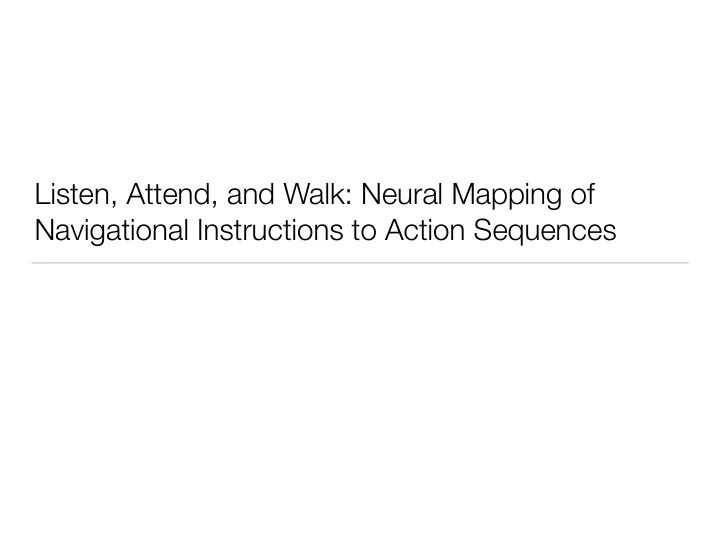

Listen, Attend, and Walk: Neural Mapping of Navigational Instructions to Action Sequences
Motivation • Command robots using natural language instructions • Free-form instructions are di ffi cult for robots to interpret due to its ambiguity and complexity • Previous methods rely on language semantics to parse natural language instructions • Can robot learn the mapping from instructions to actions directly?
Previous Work • Symbol grounding problem (Harnad 1990): What is the meaning of words (symbols)? • How do the words in our head connects to things they refer to in the real world? • Manual mapping of words to environment features and actions (MacMahon 2006) • Corpus of 786 route instructions from 6 people in 3 large indoor environments • Instructions were validated by 36 people with 69% completion rate • MACRO: • Interpret instructions linguistically to obtain meaning • Combine linguistic meaning with spatial knowledge to compose action sequence • Infer actions via exploratory actions • 61% completion rate
Previous Work • MACRO: simulated environment for indoor navigation • Hallways with pattern on the fm oor • Paintings on the wall • Objects at intersections • Ti is setup and dataset is used in this paper
Previous Work • Translate instructions into formal language equivalent • Learning a parser to handle the mapping • Use probabilistic context free grammar to parse free-form instructions into formal actions (Kim and Mooney 2013) • Mapping instructions to features in the world model • Use generative model of the world and learn a model for spatial relations, adverbs and verbs (Kollar 2010) • Parse the free-form instructions and and use probability distribution to express the learned relation between words and actions
Problem Statement Sequence to sequence learning problem • Translating navigational instructions to sequence of actions • Knowledge of the local environment in the agent’s line-of-sight • Understand the natural language commands and map words in the • instructions to correct actions Instructions may not be completely speci fj ed •
Problem Statement • Variables • x (i) , variable length natural language instructions • y (i) , observable environment (world state) • a (i) , action sequence • Mapping instructions to action sequence • a 1:T = arg max P(a 1:T | y 1:T , x 1:N ) a 1:T
Implementation: Encoder • Encoder-decoder architecture for sequence to sequence mapping • Encoder: Bidirectional Recurrent Neural Net (BiRNN) • h j = f(x j , h j-1 , h j+1 ) , the encoder’s hidden state for word j • Hidden states h are obtained via feeding instructions x to Long Short-Term Memory(LSTM)-RNN • h describes the temporal relationships between previous words
Implementation: Overview
Implementation: Encoder • Why LSTM-RNN? • RNN handles variable length input: input sequence of symbols are compressed into the context vector (h) • RNN models the sequence probabilistically • LSTM is shown to provide better recurrent activation function for RNN: LSTM unit “remembers” previous information better
Implementation: Multi-Level Aligner • x j and h j describes the instruction and the context • aligner decides which part of input will have higher in fm uence (attention weight) and help the decoder to focus depending on the context • Ti is paper included x j in the aligner to improve performance • both high-level (h) and low-level (x) representations are considered by the aligner • Ti e model can o ff set information lost in abstraction of the instruction • z t = c(h 1 , …, h N ) , the context vector to encode instructions at time t - this is for the decoder
Implementation: Decoder • LSTM-RNN • decoder takes world state (y t ) and context of instruction (z t ) as input • Ti e output is the conditional probability for the next action
Implementation: Training • Objective • • Loss function • • Parameters are learned through back-propagation
Experiment: Setup • SAIL route instruction dataset (MacMahon, 2006) • Local environment: features and objects in line-of-slight • Single-sentence and multi-sentence task • Training • 3 maps for 3-fold cross validation • for each map, 90% training and 10% validation
Results • Outperforms state-of-the-art in single sentence task • Competitive result for multi-sentence task
Results: Ablation Studies and Distance Evaluation • Ti e encoder-decoder architecture using RNN with multi-level aligner can signi fj cantly improve performance • In the failure cases, the model can produce end-points that are close to the destination
Conclusion • LSTM-RNN with multi-level aligner achieves a new state-of- the-art performance on single sentence navigation task • Ti is model does not require linguistic knowledge and can be trained end-to-end • Low-level context (the original input) is shown to improve performance
Discussion • Ti is problem is very similar to the machine translation problem, with additional environment information for the model to make the decision • Ti e authors’ approach is largely inspired by advances in neural machine translation and encoder-decoder architecture • Ti e model does not implement exploratory behaviour nor correcting mistakes • It would be interesting to investigate the e ff ect of error in the instructions in leading to the failed navigation • Multilevel alignment and the use of BiRNN greatly increase model complexity
Recommend
More recommend